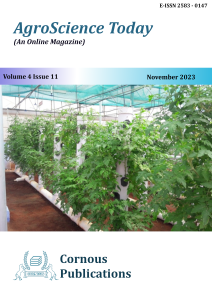A quantity of 160g/day/person vegetables is consumed against the ICMR recommendation (300g/day/person). Area expansion for vegetable crops is very limited, because cultivable lands are utilized for non-agricultural activities. Alternate growing medium may be used for stable vegetable production to save the natural resources. Under this scenario, hydroponics is one of the alternate production system for raising the crops in nutrient solutions. The media required for hydroponics are coir compost, peat, perlite, sand, vermiculite and rock wool. Majority of these units function automatically to manage the movement of water, fertilizers and light requirements for various crops viz., tomato, cucumber, chilli, brinjal, strawberry and lettuce.
Geranium was originated from Cape Province in South Africa. Most important types of geranium are Algerian or Tunisian and Reunion types. Among these two types, Algerian types have delicate odour than Reunion type. However, Reunion type is widely raised in the Nilgiris and Anamalai. Warm winter with mild summer temperature and uniform distribution of total annual precipitation from 1000 -1500 mm are most suited to this crop. The cuttings taken from terminal stem with 20 cm long (eight nodes) is the best planting material for multiplication. A total of 30,000 cuttings are required to plant one hectare area.
The micro greens have only one central shoot and the same will cut in the collar region at the time of harvesting. They have completely grown cotyledon leaves with one pair of very small, immature true leaves. They are cut within two weeks days from the date of sowing. Red cabbage, Amaranthus and radish greens are raised as microgreen and these crops having maximum ranges of vitamins C, K and E respectively. They are rich in flavour and raised in diversified shapes, textures and colours of leaves.
The present developments in genetics and plant breeding gave a flexible way for sequencing, tagging, mapping and introgression of a gene for the required character at cheapest price, but it takes long time. Speed breeding combined with other tools lead to reduce the breeding cycle, generation advancement and accelerates the development of varieties in minimum period. Combination of speed breeding with other genetic tools like genome editing, marker assisted backcrossing, transgenic approaches to develop homozygous inbred lines followed by crossing will facilitate rapid cycling, genetic gain and rapid development of improved cultivars.
Buckwheat (Fagopyrum esculentum) originated in the Tibetian Plateau or nearby mountain of Yunnan, SW China. It is associated with the Family Polygonaceae and comes under the category of dicot pseudo-cereals which is quite different from monocot cereals. In India two species of buckwheat i.e F.esculentum and F.tataricum are commonly cultivated. It is Gluten free Super food which is rich in vitamins B1, B2, E, protein, fibres, carbohydrates and minerals. Among its health benefits it may improve heart diseaces, promote weight loss, helps in sugar control and an alternative for Celiac disease. However, cereal products are deficient in lysine and protein contents which are high in this crop. It performs multiple functions such as green manure crop, nutrient conserving crop, break crop, smother crop and as land reclamation crop. Generally, people during religious fasting days consume many products made out of this crop in India. The grains and flour is used in making chapattis, biscuits, noodles etc. It has the potential to suppress insect-pest life cycle and also root pathogens in soil. It has Rutin and Fagopyrin which helps in curing various human diseases such as hemorrhage, edema, purpurea, kidney disorders, carcinogenic and stabilizes high blood pressure.
